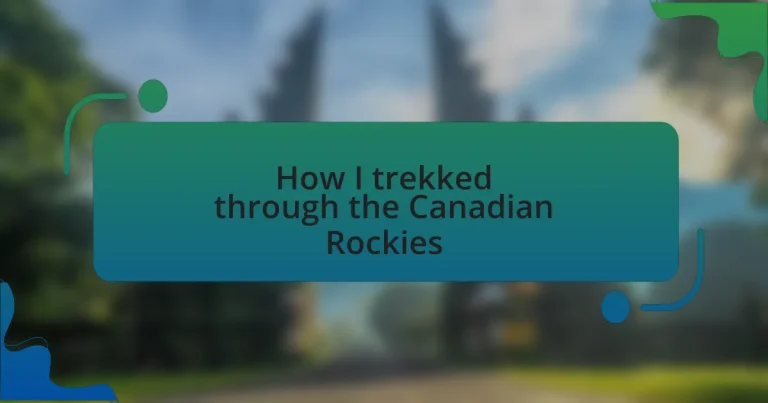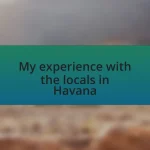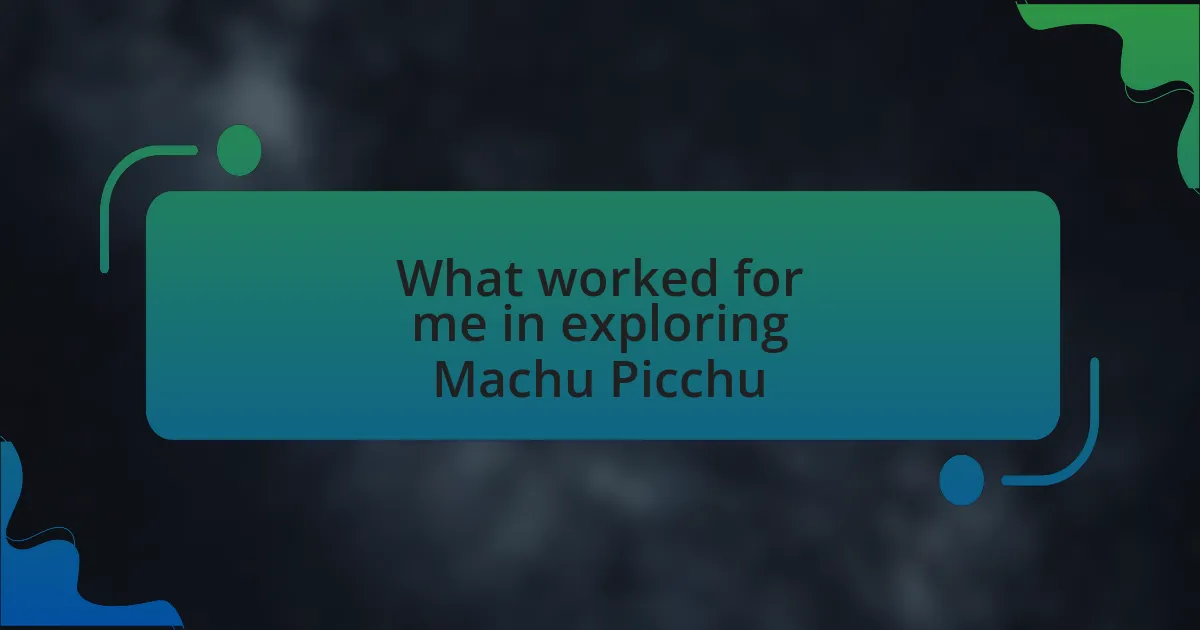Key takeaways:
- Travel blogging is an art that combines storytelling with personal experience, fostering deep connections with readers through vulnerability.
- Effective planning and selecting the right gear are essential for an enjoyable trekking experience, enhancing both comfort and exploration.
- Documenting journeys through journaling and photography not only preserves memories but also enriches the sense of community when shared online.
- Engaging your audience requires authenticity, open-ended questions, and vivid storytelling to create emotional connections.
Author: Evelyn Hartley
Bio: Evelyn Hartley is a bestselling author known for her compelling historical novels that delve into the complexities of human relationships. With a background in literature and a passion for storytelling, she crafts richly detailed narratives that transport readers to different eras. Her award-winning debut novel, “Whispers of the Past,” was praised for its vivid characters and intricate plots. When she’s not writing, Evelyn enjoys exploring antique shops and researching the fascinating stories behind forgotten artifacts. She resides in a charming cottage in Vermont, where she draws inspiration from the beauty of nature and the stories it holds.
Understanding travel blogging
Travel blogging is about sharing experiences, but it’s also an art of storytelling that captures the emotional essence of each journey. I remember standing at the edge of a breathtaking canyon in the Canadian Rockies, feeling an overwhelming sense of wonder. How often do we find ourselves speechless in the presence of nature’s grandeur? That moment fueled my desire to convey not just the sights, but the feelings tied to every experience I encountered.
As I crafted my posts, I realized that it wasn’t just about the locations I visited; it was about my personal transformation as well. Writing about my challenges during the trek—like navigating steep trails while battling my own doubts—allowed readers to connect with my journey on a deeper level. Isn’t it fascinating how vulnerability can forge a connection between the writer and the audience?
Moreover, effective travel blogging bridges the gap between inspiration and information. Sharing practical tips alongside vivid narratives allows readers to imagine themselves in those scenarios. When I detailed how I prepared for the unpredictable weather in the Rockies, it wasn’t just a list of items; it became part of our shared adventure. Isn’t that the true essence of travel blogging? It’s about inspiring others to explore while feeling like they are right there with you.
Benefits of travel blogging
Travel blogging offers a unique opportunity for personal growth. Each time I share my stories, I reflect on my experiences and how they’ve shaped me. Have you ever considered how revisiting your travels through writing can help clarify your thoughts? For me, it often brings to light lessons learned—whether it was the beauty of slowing down to appreciate a sunset or the importance of preparation in less than ideal weather.
Additionally, there’s a profound community aspect to travel blogging that fosters connections with like-minded individuals. I remember the excitement I felt when a fellow traveler reached out after reading about my encounters in the Rockies. It made me realize that our shared love for exploration creates bonds that transcend location. Isn’t it exhilarating to think that your words can inspire someone to embark on their own adventure?
Moreover, travel blogging cultivates creativity and expression. I often find myself experimenting with different styles of storytelling and photography. When I started incorporating my artistic reflections into posts about the Canadian Rockies, I discovered a new layer of storytelling that resonated deeply with my audience. Isn’t that a beautiful realization—that your own explorations can fuel not just your journey, but the creativity of others as well?
Planning your travel itinerary
When planning my travel itinerary for the Canadian Rockies, I found it crucial to prioritize my must-see locations. I distinctly remember sitting with a map, tracing routes and circling highlights like Lake Louise and Banff National Park. It’s all too easy to get overwhelmed by choices—how do you make sense of it all without losing your sanity?
Time management also played a significant role in my planning. I learned that allocating more time to explore specific areas, rather than rushing from one destination to the next, allowed me to truly absorb my surroundings. For instance, spending an extra day in Jasper gave me the chance to hike the stunning Maligne Canyon without feeling pressed for time. Have you ever felt like you missed out because you were on a tight schedule? I have, and it reminded me that sometimes, less really is more.
Lastly, accommodation options can significantly impact your overall experience. I vividly recall the cozy lodge I booked near Yoho National Park. Waking up to the sound of gentle rain and a view of the misty mountains helped ground my journey in nature. Have you ever chosen a place to stay that became part of your adventure? I believe that finding the right lodging is just as essential as the activities you fill your days with—it sets the tone for your entire trip.
Gear and supplies for trekking
Selecting the right gear was essential for my trek through the Canadian Rockies. I vividly remember the moment I found the perfect backpack—it was lightweight yet spacious enough to carry my essentials. It’s funny how the right pack can feel like an extension of yourself on the trail. Have you ever felt that sense of comfort from gear that just fits?
When it came to footwear, I relied on my trusty hiking boots, which have seen many miles and weathered storms. The moment I laced them up before my first hike, I instantly felt a surge of confidence. Comfortable, sturdy boots made tackling rocky paths and muddy trails manageable. I can’t stress enough how investing in good footwear can transform your trekking experience.
For clothing, layering was my go-to strategy. On one memorable day, I started in the chilly early morning mist, clad in a thermal base layer, and by midday, I was peeling off layers as the sun shone bright. That ability to adapt to changing temperatures was invaluable. Have you ever experienced weather shifts while trekking? It reminded me of the importance of being prepared for anything nature throws your way.
Documenting your trekking experience
When documenting your trekking experience, I found that keeping a daily journal was incredibly valuable. Each evening, I would sit by the campfire and jot down my thoughts and feelings about the day’s adventures. It was amazing how capturing the moment transformed fleeting memories into lasting reflections. Have you ever looked back at a trip and wished you’d recorded more of your thoughts? Writing it down made every moment feel even more significant.
I also made extensive use of photography, snapping pictures that highlighted not just the scenery but also my emotions during the trek. One picture that stands out was taken at a stunning viewpoint, where I couldn’t help but smile as the beauty of the landscape overwhelmed me. That feeling of awe was encapsulated in that single frame, allowing me to revisit that moment whenever I pleased. How do your photos encapsulate your experiences alongside the stunning views?
Finally, I embraced social media to share my journey in real-time. The thrill of posting updates from the trail, sharing not just stunning images but also the challenges I faced, created a sense of community among my followers. It was almost like trekking with friends, even if we were miles apart. Engaging with others through comments and messages enriched my experience—it made me feel connected to a larger world while I was adventuring in nature. How do you think sharing your travels affects your overall experience? For me, it added a layer of joy and interaction that I hadn’t anticipated.
Sharing stories and photos online
Sharing stories and photos online during my trek was like inviting others into my journey. Each post became a chapter of my adventure, capturing not just the sights but also the emotions I felt. I remember a moment when I uploaded a photo of a peaceful lake at sunrise, and a friend commented that it felt like a scene from a dream. How incredible is it that sharing a glimpse of my experience could evoke such feelings in someone else?
As I posted regularly, I noticed how the feedback transformed my perspective on the trek. Seeing my friends’ reactions cheered me on, especially during tough moments when the trails became challenging. For instance, after sharing a photo of a steep ascent with a caption about my struggle, I received encouragement from fellow trekkers who had faced similar challenges. It’s fascinating how our stories can resonate with others, fostering a sense of connection even from afar—don’t you feel uplifted when others relate to your experiences?
Additionally, I loved the creative aspect of storytelling online. Experimenting with different angles and captions helped me reflect on what each moment meant to me. One day, a friend messaged me to ask about the backstory behind a candid shot of me laughing on a difficult section of the trail. I realized then that sharing the raw moments—the laughter, the exhaustion—made my journey more relatable. Isn’t it amazing how storytelling can break down barriers and create bonds with others, even when you’re miles away from them?
Tips for engaging your audience
When engaging your audience, authenticity is key. I remember one evening by the campfire, sharing a candid moment of vulnerability about how I felt overwhelmed by the vast wilderness around me. I typed out my fears and triumphs, and the response was overwhelming; people appreciated my honesty. Have you ever thought about how sharing your true self can forge deeper connections with your readers?
Another effective strategy is to ask open-ended questions in your posts. During my trek, I would often prompt followers to share their favorite hiking memories or challenges they’ve faced. The stories that came pouring in created an exciting dialogue, transforming my solo adventure into a collective experience. Isn’t it powerful to realize that your journey has the potential to inspire others to share their own?
Finally, use storytelling to create vivid, emotional landscapes that pull readers in. I vividly described the moment I reached a mountain peak, feeling a rush of adrenaline mixed with disbelief. The way I captured that intense emotion resonated deeply with my audience. Have you noticed how painting a picture with words can transport people, making them feel as if they are right there beside you on the trail?




